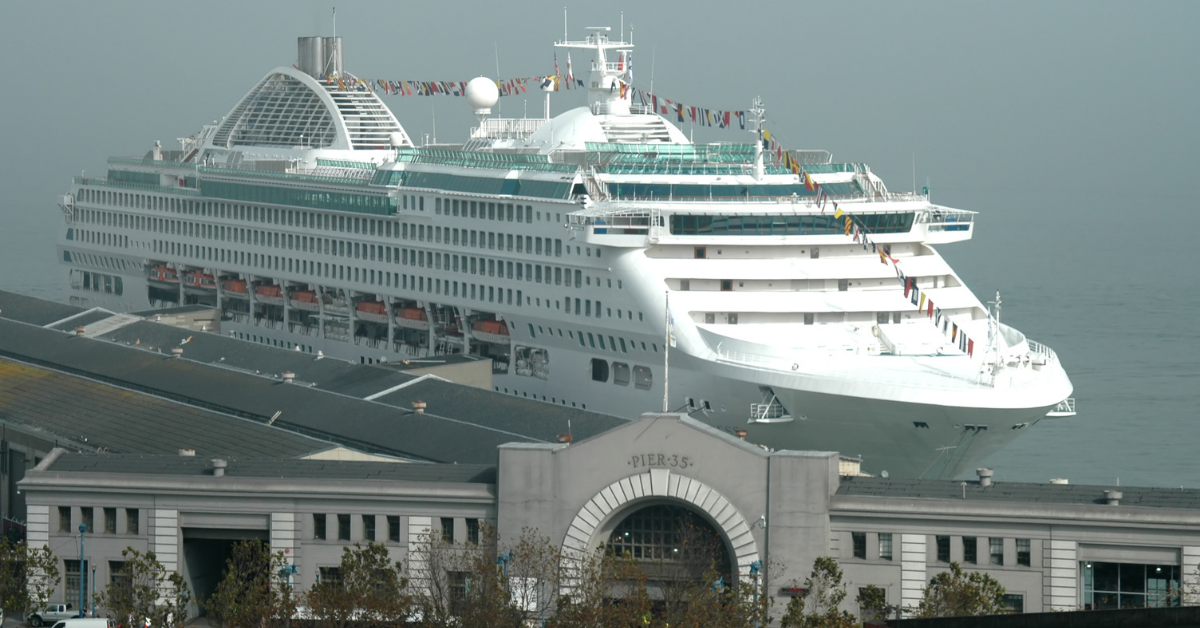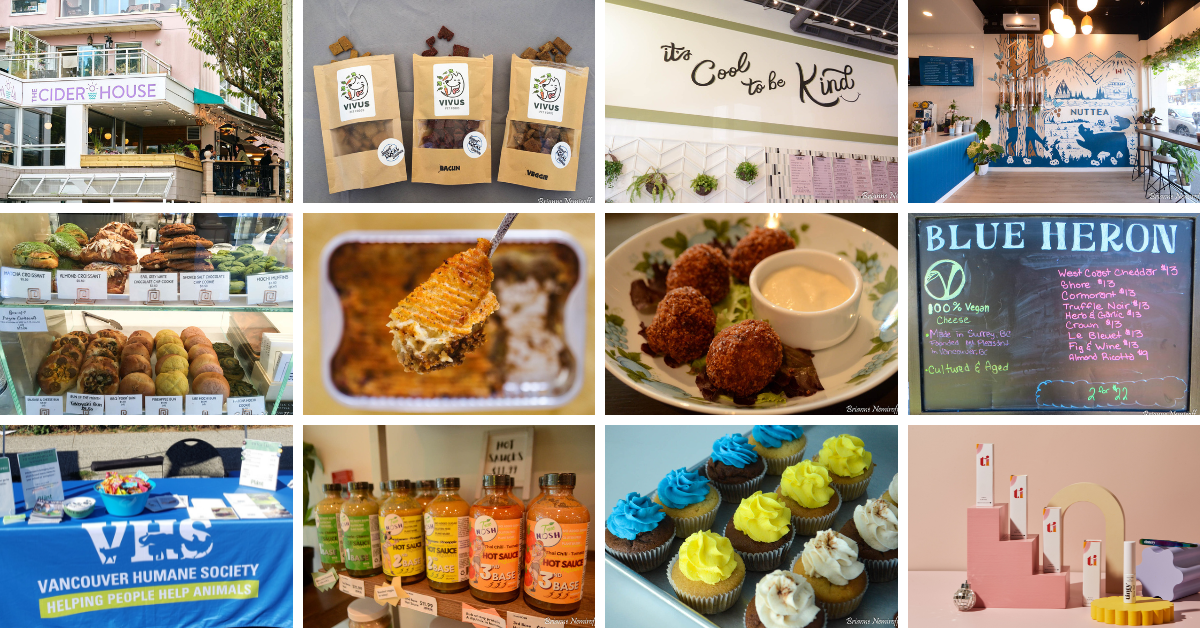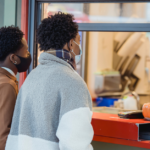It’s an image that has adorned the cover of almost every cruise brochure and advertisement since ocean cruising exploded in the 1980s: a behemoth, pristine-white ship in the bay of an idyllic coastal village or city in the Caribbean. An airbrushed Adonis-like man and a blond woman with 2% body fat between the two are splayed across the ship’s deck, the beach, or a restaurant. An extravagant alcoholic drink never leaves their hands.
As is typically in marketing, this is all a romantic fantasy. In reality, the ship is spewing waste of all forms into the air and water around it. The coastal city is not idyllic as its entire economy and most valuable land is devoted to tourism and causing even greater disparity between the wealthy and impoverished. And that attractive couple is oblivious to all of it as it only explores and shops at the tourist centers near the dock. While there are more and more cruises arriving to the world’s stage that are making greener choices and offering more vegan options, the cruise industry itself is still an immense threat to human health, environmental health, and the ports they dock.
Not only do we go into detail about the reality of the damage that cruises cause on a daily basis, but we also provide you a list of questions to ask the cruise companies directly if you decide you’d like to book with an ethical cruise company in the near future.
How Cruises Affect Human Health
Among the most popular allures of taking a cruise is the food. Let’s face it, with ads showcasing endless buffets of common and fine dining options, decadent gourmet dishes that look like pieces of art, sushi rolls as long as tables, rich cakes with frosting that glistens, and alcohol available at any hour, why would anyone NOT want to be on a cruise?
The setting is a fantasy to so many: the excuse to eat anything pleasing in copious amounts. However, this fantasy becomes a nightmare within a few days. Most cruise lines serve over-salted, sugared, and trans fat-laden foods as they are more likely to excite the pleasure center in passengers’ brains, thereby making us want to eat more and more. The curators of these menus also believe that their diners want and expect these flavors in their meals, so they’ll make extra effort to include them.

Even dishes that are commonly perceived as nutritious, like salads, are often laden with oil and salt. Worst of all, many popular cruise lines have been cited for not cooking their meals as thoroughly as necessary, leading to them being some of the most likely places for rapid outbreaks of salmonella and norovirus. The close and contained quarters of ships also are ideal incubators for very deadly diseases like COVID-19. All in all, all of these meal choices are low in nutritional value. Any passengers’ health will begin to wane and cause illness in great numbers.
It’s not just the passengers who receive the poor effects of the ship’s environment; its crew does, too. In decades past, a ship’s crew and workers supplemented their wages by gratuity that passengers gave them in cash, and on many occasions throughout the course of a cruise. In the past decade, more and more cruise lines have had a single gratuity added to the total fare of the ticket. While this may be more convenient to the passenger, the employees aboard the ship have seen their supplemental income drop steadily as “their base salaries have decreased by the amount they now receive in gratuity.”
Housekeepers from developed nations who work aboard some of the largest lines today make $50 per month, on average, and work twelve hours a day, which is below the minimum in the U.S. “They rarely leave the ship during those months and then for a few hours at the most” when they do. “In essence, they rely on tips from passengers for their wages…they have free room and board, but they are required to pay for their airfare to the ship and back home.” Consequently, they must “earn $1,500 in tips each month to cover expenses and earn a small living,” (“Overbooked”, pg. 126-132). The reduced income is not the only hardship that they must endure. Crew and workers also have to put up with cell-sized quarters that are window-less and below sea-level for the duration of their contract.
How the Cruise Industry Hurt the Environment
The effects of cruises surely ail the bodies and incomes of their passengers and employees, but their biggest victim is the environment that surrounds them. In terms of waste, cruise ships are major producers of many different types. An ocean cruise ship has an average passenger complement (a.k.a. capacity) of 2,700, and each ship produces 25,000 gallons of sewage, 143,000 gallons of sewage from sinks, galleys and showers, 7 tons of garbage and solid waste, 15 gallons of toxic chemicals, and 7,000 gallons of oily bilge water—DAILY.
Now, it is true that many of the major lines around the world have pledged to monitor and curb this amount of waste from each of their ships, yet the largest ones in the cruise industry haven’t even begun to make progress. In 2016, Princess Cruise Lines received a “C” rating on Friends of the Earth’s cruise ship report card, which grades companies on sewage treatment, air pollution reduction, water quality compliance, and transparency—the same grade the cruise line received in 2014, and a full grade below the B it received in 2013. Of the 17 cruise lines evaluated, only Disney Cruise Lines received above a C in 2016 (it earned an A-); the majority scored below that, with eight Ds and four Fs. These environmental concerns will only become more pressing as the cruise industry grows.
On an individual level, each passenger’s carbon footprint while cruising is roughly three times what it would be on land . One may then think that current laws are effective in keeping the amount of waste low. That is true in certain places, like Alaska, California, and Maine, who have tough coastal anti-pollution state laws, yet the limits are less stringent beyond their shores, and are nearly non-existent under U.S. federal law. Since 2000, only one act was introduced in the U.S. Congress to create a standardized national cap on ship pollution, yet it never moved forward.

Most cruise lines don’t have unified or strict policies to curb the amount of this waste, so they often aren’t compelled to dispose of it responsibly. At the time of this writing, “cruise ships are not subject to the requirement for federal permits covering sewer and waste disposal systems that are (the same) for the resorts and hotels on land. As a result, all of those millions of passengers and crew members dining and defecating and showering on the oceans have left filthy discharges in their wake,” (Overbooked, 133-134).
The ships, with their massive engines, turbines, and noise from the decks produce so much noise pollution that it has damaged both ecosystems in the ocean and along coasts, and the “cruise crowds streaming into foreign ports by the thousands have disfigured beaches and plazas,” (Overbooked, 134). The very presence of ships also creates visual pollution as well. Often passengers are sold on the romanticized vision of their lone vessel surrounded by overwhelming natural scenery. With so many cruise lines competing for ports and sights, their thousands of ships routinely overlap routes. This causes lines, in upwards of a dozen, through popular routes like Glacier Bay National Park. Would you really want to spend that much money to be in a nautical traffic jam?
How the Cruise Industry Hurts the Local Economy and Culture
The cruise industry doesn’t just harm the natural environments, but also the human ones. The kind of behavior that it markets and promotes—that of abandoned concerns and disregard for responsibility—makes its passengers unaware of their impact on the economy of each destination.
When arriving into port, passengers are excited to go shopping for local curios as they are under the impression that the dollars that they pay each artisan or merchant will be distributed throughout the local economy. The reality is that the merchants are hired to set up shop by the cruise and port companies themselves. The merchants may get a cut of what they make, but most of it goes to the aforementioned companies just for the right to set up shop there.

The cultural excursions are just as detrimental. Passengers are most often not allowed to book excursions beyond the port with local, 3rd-party companies. Cruise companies respond to this observation that it’s for safety and to ensure that passengers don’t miss their boarding time, yet the largest rationale for this policy is so that the cruises profit more. They choose the tour company that you have to use, and they get most of the cut while a fraction goes to the guides themselves. Since these tours are organized with the cruise company’s oversight, this leads to itineraries with watered-down, simplistically-curated cultural experiences that only showcase what the tourists expect to see and not how it really is.
Just a quick glance at the Princess Cruise itinerary for Southeast Asia features Sihanoukville, Cambodia, and the excursions include the densely-trafficked Angkor Wat, a non-descript Cambodian village that’s been curated specifically for tourists, and beaches with “idyllic white-sand beaches with upscale resort hotels where (passengers) can snorkel, scuba dive and enjoy fresh seafood.” There isn’t any mention of educational tours about current daily life, or even about recent history, like the Killing Fields. This then leaves a myriad of people uneducated about global issues when these are actually the ideal opportunities to do so.
Local governments are then pressured to develop and plan their communities around and for tourists. Farmers and blue-collar workers are evicted from their lands, and five-star restaurants, high-end hotels, and luxury brand shopping malls are built in their stead, leaving less available and affordable land for locals. In the end, the economies of these destinations become dependent solely on tourism and voluntarily collapse whenever the cruise industry slows, like say, during a pandemic.
Cruise companies also tend to disregard the safety and sovereignty of the governments of their destinations. Most recently, and perhaps most notoriously, they had been pressuring ports across several Caribbean nations to remain open and accept tourists during the COVID-19 pandemic. “The Dominican Republic turned away the (Fred Olsen Cruise Lines) Braemar at the end of February due to health officials’ concerns about flu-like symptoms reported on board. The cruise company called the decision an ‘overreaction’ and (rerouted the ship) to a port in St. Maarten. Passengers disembarked and new ones filed on board. From there, the Braemar headed to Cartagena, Colombia, where an American who disembarked became the first recorded coronavirus case in the city.”
The Questions to Ask to Ensure You Book with an Eco-Friendly Cruise Line
Now that the unconscionable acts of the cruise industry have been listed out, does this mean that we as eco-conscious explorers can never set foot aboard a ship without risk of devastating all that in its wake? The short answer is no, but we must take care in how we search for and choose a voyage.
While the largest and oldest lines are just beginning to understand the concept of reducing waste, many newer lines, like UnCruise Adventures, are making “clear commitments to reducing waste and abiding by responsible labor laws, my guides offered thoughtful educational programs…Companies such as UnCruise provide refillable water bottles to guests free of charge to use throughout the trip, cutting down on the need for single-use plastic bottles.” There are eco-conscious cruise and tour companies out there, but it’s up to each of us to hold each one accountable by asking the following before booking your dream cruise:
Does the company partner with or donate money to any nonprofits that play a role in global stewardship?
A nonprofit partnership is a good signifier that the cruise line has a vested interest in supporting conservation work, engaging with communities, and sharing economic benefits. You can normally find these partnerships on the company’s webpage in the “About Us” section.
How does the company manage its waste?
Don’t just ask whether cruise lines recycle, but which items they recycle (e.g., what kinds of plastics), how they reduce the use of disposable items, and what actions they take to prevent waste from the start.
Does the company hire local guides and work with local souvenir vendors?
If you travel with a major cruise line, you will likely be responsible for planning your own shore excursions in each port destination. Most companies have a slew of different options on their websites, which you can book directly through them. Seeking out locally-owned tour operators will help ensure that your money stays in the region you are visiting. Supporting local restaurants and purchasing locally-made handicrafts and souvenirs instead of mass-produced items also bolsters tourism economies. Basic internet research on the port cities you are visiting can help you find good local businesses in advance of your trip.
Does the company pay its staff adequately and follow reasonable labor standards?
Some cruise lines register their ships in countries that allow them to pay low to no taxes, offer low wages and poor on-board conditions for staff, and avoid strict labor regulations. One way to know if a cruise operator is abiding by U.S. statutes and regulations is to confirm that the ships it uses were built in the U.S., are owned by a U.S. company, and are staffed with a U.S. crew (thereby meeting U.S. minimum wage laws). Sadly, there is only one ship with a major cruise line at the time of this writing that meets these criteria: the Pride of America, based in Hawaii. This is one reason it is worthwhile to look at small-ship cruise lines as an alternative, since smaller businesses are more likely to register in their home countries and invest more in their workers. Plus, smaller ships can offer more personalized services and a greater sense of rapport with staff and other passengers. Regardless, remember to do your part and include tips for service workers in your travel budget.
Where/how does the company source its food?
Ask whether the company makes an active effort to source foods locally in the destinations they are serving. This helps to keep money in the local ports while giving you a more immersive cultural experience.

To Cruise or Not to Cruise?
While it is true that the cruise industry has been harmful to human and environmental welfare for decades, it doesn’t necessarily have to remain that way. As long as we continue to see past the glossy brochures and support those that are doing no harm, then the industry has the opportunity to be one for social and ecological good.
Interested in more articles like this one? Sign up for our newsletter via the form on the right.
















2 Responses
good information to know, thank you for this post!
You’re welcome! It’s certainly eye-opening!